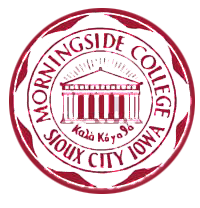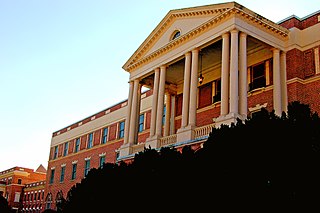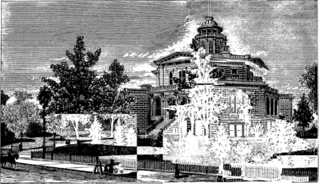Related Research Articles
The Methodist Episcopal Church, South was the American Methodist denomination resulting from the 19th-century split over the issue of slavery in the Methodist Episcopal Church (MEC). Disagreement on this issue had been increasing in strength for decades between churches of the Northern and Southern United States; in 1845 it resulted in a schism at the General Conference of the MEC held in Louisville, Kentucky.

Clark Atlanta University is a private, Methodist, historically black research university in Atlanta, Georgia. Clark Atlanta is the first Historically Black College or University (HBCU) in the Southern United States. Founded on September 19, 1865 as Atlanta University, it consolidated with Clark College to form Clark Atlanta University in 1988. It is classified among "R2: Doctoral Universities – High research activity".

Morningside University is a private university affiliated with the United Methodist Church and located in Sioux City, Iowa. Founded in 1894 by the Methodist Episcopal Church, Morningside University has 21 buildings on a 68-acre (280,000 m2) campus in Sioux City. The Morningside College Historic District, which includes most of the campus, is on the National Register of Historic Places. Morningside College officially became Morningside University on June 1, 2021.

Central State University (CSU) is a public, historically black land-grant university in Wilberforce, Ohio. It is a member-school of the Thurgood Marshall College Fund.

Morrison Observatory is an astronomical observatory owned and operated by Central Methodist University located in Fayette, Missouri (USA). It was named after Bernice Morrison who, in 1874, pledged $100,000 to C. W. Pritchett for the construction of the observatory. Half of that amount would go the construction of the telescope and observatory; the other half to a permanent trust fund. The observatory was built soon afterwards in Glasgow, Missouri at Pritchett College and opened in 1875.

The Interdenominational Theological Center (ITC) is a consortium of five predominantly African-American denominational Christian seminaries in Atlanta, Georgia, operating together as a professional graduate school of theology. It is the largest free-standing African-American theological school in the United States.

Lewis Woodson was an educator, minister, writer, and abolitionist. He was an early leader in the African Methodist Episcopal Church (AME) in Ohio and Pennsylvania. Woodson started and helped to build other institutions within the free African-American communities in Ohio and western Pennsylvania prior to the American Civil War.
The Genesee Wesleyan Seminary was the name of two institutions located on the same site in Lima, New York.
Wilbraham Wesleyan Academy was one of the oldest educational institutions of the Methodist Episcopal Church. It was established by Methodist clergy of New England in 1818. Originally located in New Market, New Hampshire, before moving to Wilbraham, Massachusetts, it was intended both for general educational purposes and for young men intending to enter the ordained ministry.

Pritchett College was a small institution that operated in Glasgow, Missouri from 1866 until 1922. It was founded as Pritchett School Institute and became known as Pritchett College after 1897.

Sullins College was a former Methodist, female, junior college in Bristol, Virginia, United States, founded about 1868 and named for David Sullins, a Methodist minister. It ceased operations after the class of 1976 graduated.
Carr Waller Pritchett Sr. (1823–1910) was an American educator and astronomer. He served briefly as president of Central College just before the American Civil War. He then became the first president of Pritchett School Institute in Glasgow, Missouri, after the war, and he was the first director of the Morrison Observatory, also in Glasgow..

The University of Missouri is a public land-grant research university in Columbia, Missouri. It is Missouri's largest university and the flagship of the four-campus University of Missouri System. MU was founded in 1839 and was the first public university west of the Mississippi River. It has been a member of the Association of American Universities since 1908 and is classified among "R1: Doctoral Universities – Very high research activity".


Duke Memorial United Methodist Church is a historic Methodist church at 504 W. Chapel Hill Street in Durham, North Carolina. It was originally established in 1886. The congregation's growth paralleled Durham's growth as a manufacturing center in the textile and tobacco industries and has maintained a close connection with Duke University. From its beginning, the church has counted among its members many of Durham's educational and industrial elite. It is named in honor of tobacco magnate and philanthropist Washington Duke and his sons, who were instrumental in the building of the church.

Scarritt College for Christian Workers was a college associated with the United Methodist Church in Nashville, Tennessee, USA. The campus is now home to Scarritt Bennett Center.

Payne Theological Seminary is an African Methodist Episcopal seminary in Wilberforce, Ohio. It is the oldest free-standing African-American seminary in the United States. Incorporated in 1894 by the African Methodist Episcopal Church, it was named after Daniel Alexander Payne, the founder of Wilberforce University. Payne was Senior Bishop of the AME Church at the time of the Seminary’s founding and served as its first dean. He was the first African-American college president.

Chaddock College was located in Quincy, Illinois. Initially known as the German and English Methodist Academy, the school was renamed Johnson College for a short time before it was organized and chartered as Chaddock College in 1878. In 1899, it was reorganized again as Chaddock Boys’ School.
Haygood Seminary, also known as Haygood Academy, was a seminary near Washington, Arkansas, United States. It was established by the Colored Methodist Episcopal Church to train African Americans in Arkansas for a career in the clergy. It was one of the first such institutions established by the CME Church. In 1927, the school relocated to Jefferson County, Arkansas, where it operated as Arkansas-Haygood Industrial College before closing during World War II.
References
- Bentley, Judy and Kathy Hagedorn, eds. Glasgow - The Way it Was. Marceline, MO: Walsworth Publishing Company, Inc., 2001.
- Smith, T. Berry (1932). “Pritchett College,” Missouri Historical Review, 26:223-235.